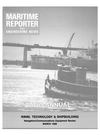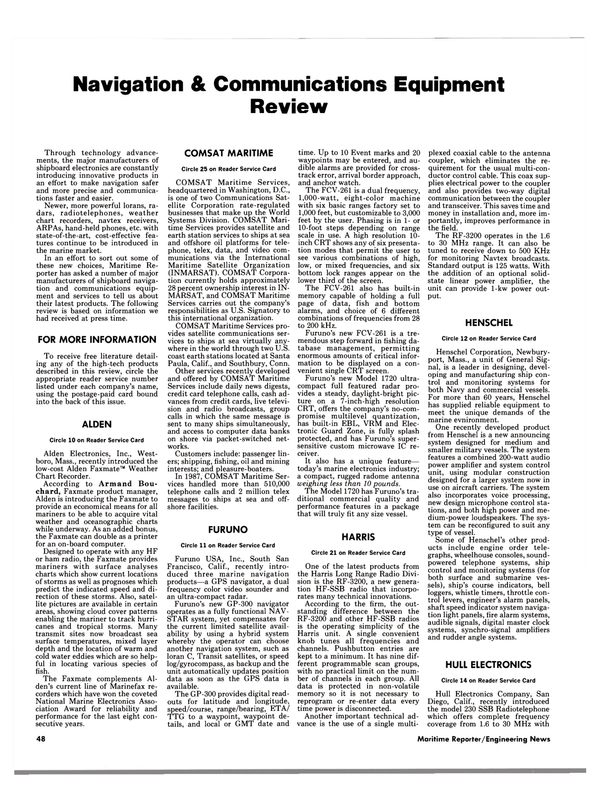
First U.S.-Built Surimi Catcher/Processor Delivered By Halter Marine
The U.S. Enterprise, reportedly the first American vessel designed and built to catch pollock and process surimi, has been delivered by Halter Marine, Inc., New Orleans, to the Arctic Alaska fleet, Seattle, Wash.
The 224-foot, 36-crew member, floating factory will be able to catch up to 250 tons of pollock per day, and process 50 tons of surimi, a paste-like substance made from pollock used to make imitation crab meat, shrimp, and other seafood products. U.S. surimi consumption increased from 6 million pounds in 1981, to over 100 million pounds in 1986.
Approximately five tons of fish are required to make one ton of surimi. The fish is filleted and skinned before mincing and washing as opposed to the Japanese system which scales and splits the fish while leaving the skin on.
The "American" method according to Francis Milller, chairman of Arctic Alaska, greatly reduces the amount of potable water required to produce surimi. The Japanese method consumes from eight to 12 pounds of water per pound of surimi, while the American system uses about five pounds of water for one pound of surimi.
The U.S. Enterprise has more than double the water making capacity required as it is equipped with an Atlas (Danmark) 110,000 gallons per day, three-stage evaporation type water maker.
The boat, which was built at Halter's Moss Point, Miss., shipyard, was originally intended for use in offshore oil and gas fields. However, when the vessel was still under construction, Mr. Miller saw her potential as a catcher/processor and he and the Halter design team redesigned it for its new use.
The U.S. Enterprise is 224 feet in length, with a 42-foot beam, and 16- foot depth. She is powered by two General Motors EMD 16-645C diesel engines developing a total of 3,900 hp through Reintjes WAV 2660 reverse/reduction gears with a ratio of 5.526:1.
The big diesels drive two Coolidge, five-blade, 118-inch diameter by 130-inch pitch, stainless steel propellers in Kort nozzles.
The U.S. Enterprise was fitted with a Westfalia model OSA 7 centrifugal purifier from Centrico. The unit, which is used to clean up the vessel's diesel fuel, was supplied to Halter Marine by Marine Engineering of New Orleans in a "Centri- Pack." The package consists of a skid or platform including the VESA automatic timing unit as well as other elements.
Electrical power for the Baader 182 and 190 filleters and skinners, other processing machinery, refrigeration, and ship's hotel service, is provided by three Detroit Diesel 380-kw generators driven by three Detroit Diesel 12V71T engines.
A fourth 12V71T engine powers a Schottel S300L bowthruster for increased maneuverability.
After processing and packaging, the surimi is placed between refrigerated plates and quick frozen. The boat's 48,000 cu. ft. refrigerated holds can store up to 1.5 million pounds of surimi.
The mid-water and bottom trawler is equipped with two Alaska Marine net cranes and two net reels.
Her large pilothouse includes two control stations with one overlooking the aft, business end of the vessel.
Some of the navigation and communications equipment on board includes two Furuno radars, two VHF and two SSB radios, and a Sperry gyrocompass and autopilot.
The $15-million U.S. Enterprise is the seventh fishing vessel built or converted by Halter Marine's Moss Point, Miss., shipyard for Francis Miller interests.
For free literature on the shipbuilding and ship-repairing facilities of Halter Marine and other Trinity Industries shipyards, Circle 65 on Reader Service Card
Read First U.S.-Built Surimi Catcher/Processor Delivered By Halter Marine in Pdf, Flash or Html5 edition of March 1988 Maritime Reporter
Other stories from March 1988 issue
Content
- FIRST A.W.O. ANNUAL ISSUE page: 4
- Crane Consolidates Two Business Units To Form Crane M i d w e st page: 6
- Unitor Ships Service Acquires G a m l e n M a r i ne page: 6
- Fort Schuyler Forum To Be Held March 16 page: 7
- Racal Wins Major Radar Order From Midland Enterprises page: 7
- Racal To Demonstrate New Color ARPA At Whitehall Club In New York City page: 8
- New Diesel Pump Company Formed page: 8
- Substantial Savings Realized With HydroSwage MK III Tube Expander page: 9
- Slingmax Rigging Products Offers Literature On New Load-Lifting Equipment page: 9
- Quality Shipyards Delivers Third Pushboat In Series of Three To Ashland Oil Company page: 10
- Centrico Offers Advanced Oil Purifying Equipment page: 10
- Alfa-Laval Offers Quality Plate Heat Exchangers For Navy Shipboard Cooling Duties page: 11
- Constant-Tension Winch For Handling Rescue Boats Offered By Braden page: 12
- New Wooster Catalog Lists Anti-Slip Safety Stair/Walkway Products page: 12
- Tate Andale Offers Free 130-Page Catalog On Marine Products page: 13
- Harriet Harrison New Chairman Of AWO Southern Region page: 13
- AWO ANNUAL page: 14
- AWO'S REGULATORY ADVOCACY page: 18
- 1987: A YEAR OF MAJOR THREATS AND IMPORTANT VICTORIES page: 23
- Why You Should Be A Member Of AWO page: 24
- NAVY WILL SPEND OVER $9 BILLION IN FY 1988 ON R&D page: 27
- Fairbanks Morse Brochure Outlines Benefits Of New Ignition Generator page: 31
- MAJOR NAVY CONTRACTS page: 33
- A&T Receives Navy Contracts Worth $14.2 Million page: 37
- Textron Marine Systems Delivers 12th LCAC To Navy page: 38
- Avondale Industries Christens Their Second Landing Ship Dock In Series Of Five page: 38
- Mid-Coast Marine To Perform Overhaul Work At Coos Bay Drydock page: 39
- Moss Point Marine Delivers First Of Four Army Landing Ships page: 40
- Bethlehem Steel Christens Navy Oceanographic Survey Ship At Sparrows Point Shipyard page: 40
- Newport News Christens Newest Nimitz Carrier page: 41
- Avondale Plans Purchase Of Lockheed Shipbuilding's Gulfport Marine Division page: 42
- Free Color Brochure On Safety Release Hook For Rescue Boats page: 42
- First U.S.-Built Surimi Catcher/Processor Delivered By Halter Marine page: 46
- Lexair Offers Catalogs On 'Hi-Cyclic' And Poppet Type Two-Way Valves page: 47
- Navigation & Communications Equipment Review page: 48
- Robertson-Shipmate Introduces Multi-Station VHF Radiotelephone To U.S. Marine Market page: 56
- New Public Dock Facility At Port Of Iberia Is Reported A Success page: 56
- Skaarup Shipping Corporation Announces Executive Changes page: 62
- Cunard Installs Computerized Maintenance System From MMS Aboard Queen Elizabeth 2 page: 62
- National Waterways Conference Cosponsoring Seminar On Transportation Futures Markets page: 65
- Caterpillar Announces Extended Service Coverage For Industrial & Marine Engines page: 68
- Hyundai Building First In Series Of Three 250,000-Dwt VLCCs For World Wide Shipping Agency page: 68


